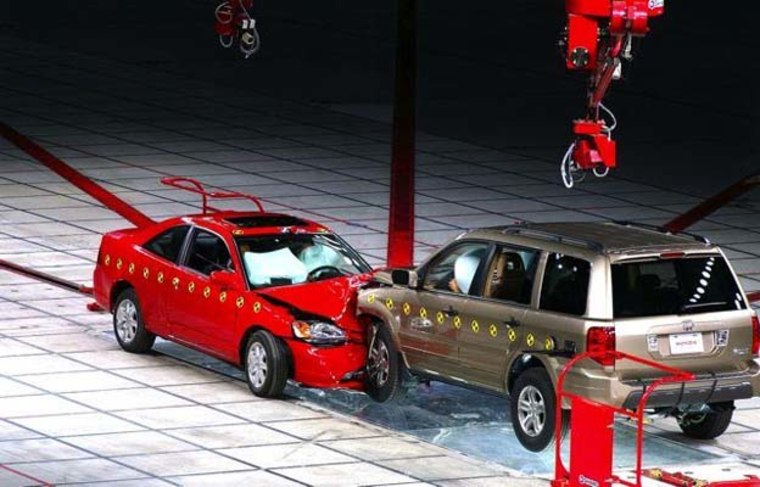In a head-on collision between a passenger car and a sport-utility vehicle, the driver of the SUV is as much as 10 times more likely to survive, according to a new study – even if the passenger car has a better crash safety rating.
The findings, to be presented at an emergency medicine conference today, show that despite more than a decade of efforts by federal regulators and automotive engineers to reduce the risks in car-truck crashes, there’s only so much that can be done to overcome the laws of physics.
Read more at The Detroit Bureau: Revived Acura NSX Supercar Will be Built in US
“The overwhelming majority of fatalities occur in the smaller and lighter of the two vehicles,” explains Dr. Dietrich Jehle, a professor of emergency medicine at New York’s Erie County Medical Center, and one of the authors of the new study conducted by the University of Buffalo.
Automakers have taken a number of steps to improve car/truck “compatibility,” changing bumper designs on SUVs, for example, so there’s more direct contact with lower sedans and coupes in a crash. Nonetheless, even when a small SUV impacts a large passenger car, the driver of the utility vehicle is more likely to survive, the research found, because the trucks are more likely to “ride over” the car, according to Dr. Jehle, “crushing the occupants.”
Read more at The Detroit Bureau: Share Price Soaring, Tesla Offers More Stock to Pay Off Fed Loan
How well occupants fare can depend upon the safety ratings of the two vehicles. If the passenger car has the better rating from the National Highway Traffic Safety Administration, a driver is still four times more likely to die. If the SUV has the better rating, that jumps to 10 times. And if crash ratings are not considered, the driver of the passenger car is about seven times more likely to be killed.
The University of Buffalo researchers noted that crash data indicates the safety of today’s SUVs is significantly better than in decades past, in part due to efforts manufacturers have made to prevent rollover crashes. Many current utility vehicle feature electronic controls designed to maintain stability in a skid or crash, while special airbags are triggered in the event there is a rollover.
Read more at The Detroit Bureau: Kia Nudges Into Luxury Market with New Cadenza
Dr. Jehle called the larger SUVs now in production “some of the safest cars on the roadways.”
Passenger cars have also seen a significant improvement in safety over the past few decades, with U.S. highway fatalities falling sharply. In 2005, 43,510 Americans were killed on the roads. That fell to 32,367 in 2011, a historic low on a miles-traveled basis. There was, however, a slight rise again in 2012 and experts are trying to understand the causes, which could have included a mild winter and the economic recovery, both leading more people to drive longer distances.
In a study released last June, meanwhile, NHTSA reported that car-truck fatalities overall declined about 8 percent between 2002 and 2010, and the drop was an even greater 17 percent in car-SUV collisions. These numbers involve different types of crashes, not just the head-on collisions the University of Buffalo study focused on.
Read more at The Detroit Bureau:Honda Will Build New Acura NSX Supercar in the US
The general downturn in the death rate reflects significant improvements in both passive safety technologies, such as airbags and modified vehicle design, and active safety systems like electronic stability control which is now required on all vehicles sold in the U.S.
Motorists are helping by paying more attention to the five-star crash rating system first created by NHTSA in 1978 – as well as a separate but widely publicized rating system created by the Insurance Institute for Highway Safety. Vehicles that don’t score well tend to feel the impact in terms of lower sales, motivating manufacturers to improve their crash safety efforts.
Read more at The Detroit Bureau:GM, Nissan Partner Up on New Chevy Truck
Nonetheless, University of Buffalo researchers cautioned that paying attention to ratings alone can provide a false sense of security. In car crashes, especially head-on collisions, basic physics can be difficult to overcome.
The new study was based on data from 83,521 fatal head-on crashes between 1995 and 2010 reports by the governments Fatality Analysis Reporting System, or FARS. The results are being presented at the annual meeting of the Society of Academic Emergency Medicine in Atlanta.
